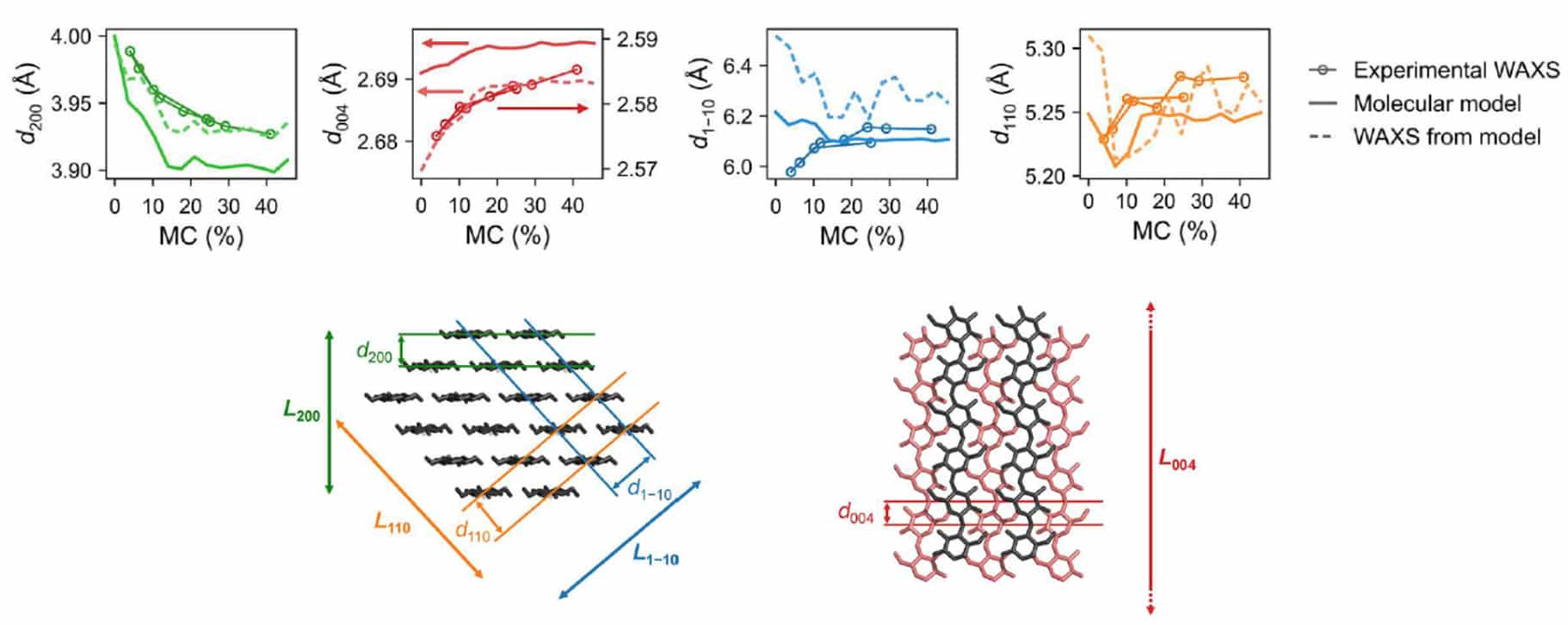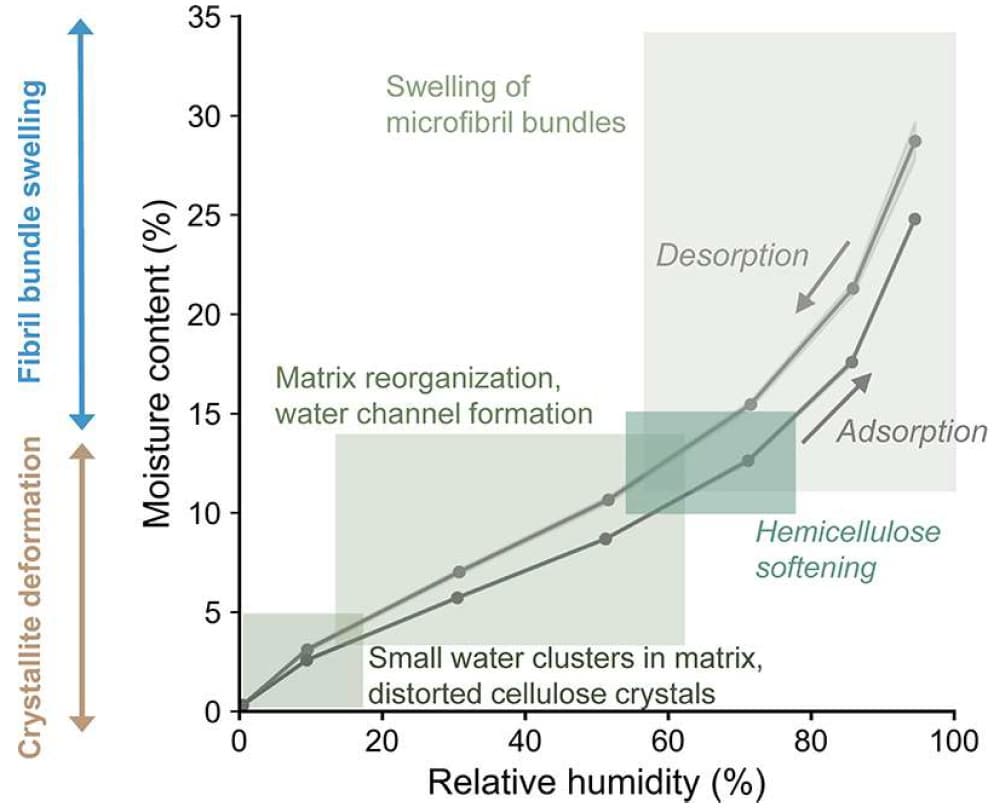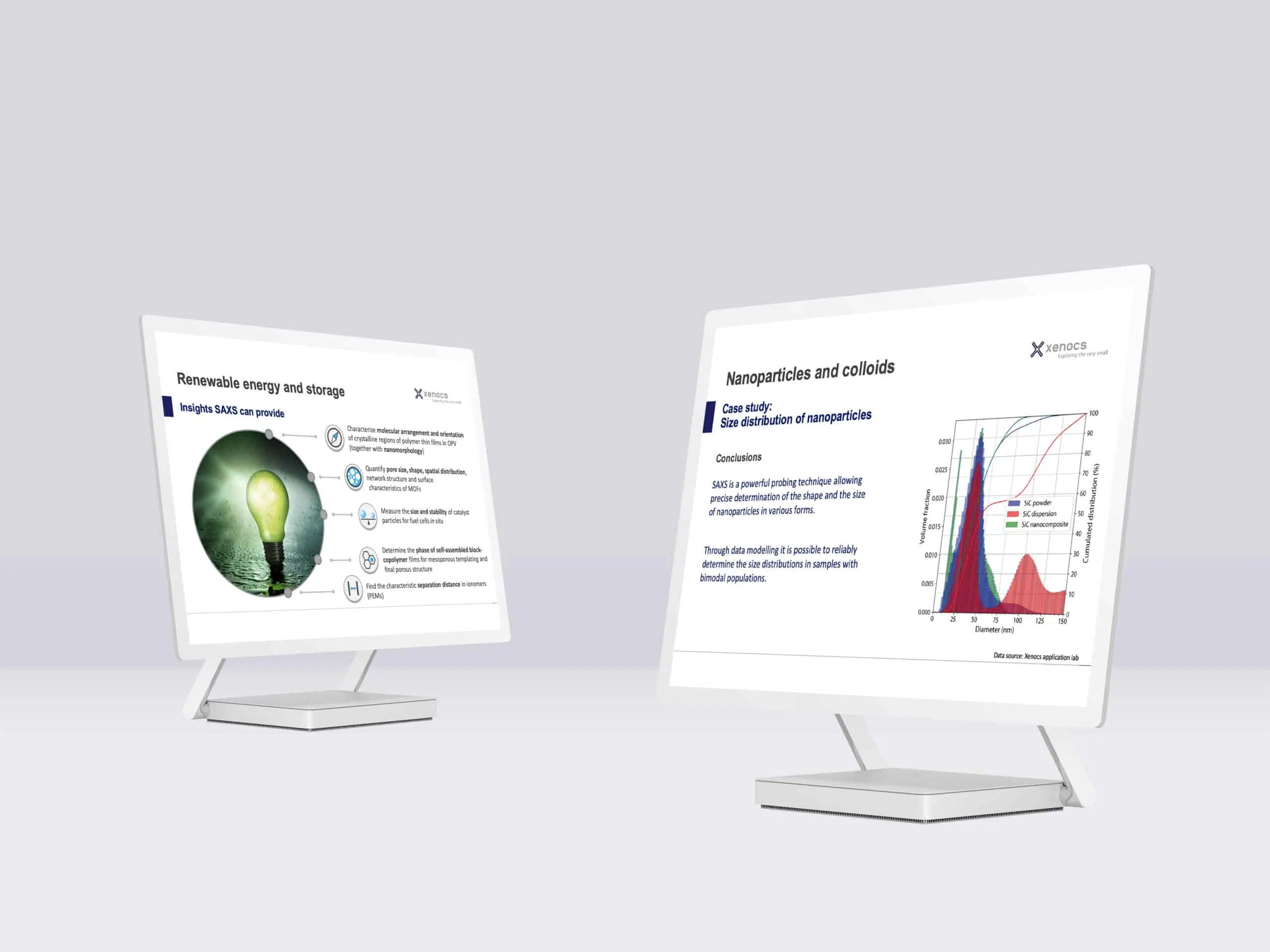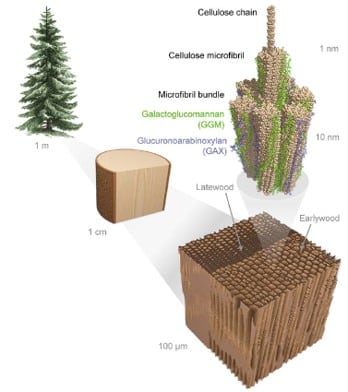在过去数十年里,人们的气候保护意识有所提高,生物纳米技术也取得了重大进展。因此,考虑到迫切的可持续性需求,木基纳米材料已在能源、生物医学、建筑等众多领域得到应用,或作为石油基聚合物的替代品[1]。尽管如此,更详细地了解植物细胞壁的纳米尺度结构将极大地提高这些材料的性能[2]。
木材是一种高度分层的材料(如图1所示),其中水是主要组成部分。它的结构组成是纤维素分子,聚集成半结晶微纤维。这些微纤维本身与半纤维素和木质素相互成束,形成了木材的次生细胞壁[3]。
小角广角X射线散射(SWAXS)是一种表征层状样品的有效办法,特别是纤维素材料,可以提供不同层级的结构信息。一方面,WAXS可以揭示纤维素微纤维的晶格间距和微晶尺寸等晶体结构特征。另一方面,SAXS可以用于研究更大的结构,如微纤维直径或排列距离。
最近,来自芬兰VTT技术研究中心和阿尔托大学的研究人员进行了原位SAXS和WAXS实验,通过分子动力学模拟证实了湿度诱导云杉木纤维素微纤维束结构的变化。
X射线和模拟结果均表明,在不同的含水率(MC)范围内,不同的分层水平(分别以SAXS和WAXS数据为代表)表现出不同的变化。在SAXS数据中,微纤维的排列距离在MC15%以上变化最大,而在15%以下时,WAXS数据表明微晶发生明显形变。
在低含水量下观察纤维素微晶的形变
原位SAXS和WAXS实验用于观察云杉木在干燥过程中的结构变化(从95%相对湿度,下降到10%)然后通过再水化使相对湿度回到95%。为此,利用湿度控制样品台来精确地改变相对湿度水平和温度(关于实验装置的详细描述见参考文献[3])。样品的实际含水量通过重量分析测试确定,它被定义为不同相对湿度下的水和干样品的质量比。
WAXS光谱显示了衍射峰位置的明显变化(如图2)。(200)和(004)衍射峰的转变最为显著,而微纤维横切面的对角线方向即(-110)和(110)峰,显示较少的变化。当MC低于15%时,(200)峰向高q值移动,而(004)峰呈现出相反的趋势。这表明,在干燥过程中,垂直于氢键层的晶格间距(d200)增大,而沿着纤维轴的晶格间距(d004)减小。这些结果与模拟模型结果一致。另外,模拟结果表明,与核心相比,这些变化在微纤维表面更为显著。

Fig. 2 从WAXS数据中提取的晶体中不同方向的晶格间距随水分含量的变化。图中包括实验值、模拟散射强度以及用颜色编码表示出晶体中的方向。Credit: Nano Letters 2022, DOI: 10.1021/acs.nanolett.2c00822.
在高含水量下观察微纤维的空间结构重组
为了接近微纤维的形状和结构,用六边形圆柱模型对SAXS数据进行拟合,揭示了微纤维排列距离的重要信息。如图3(a)所示,在干燥过程中,随着水从微纤维中间排出,在MC高于15%时,可以观察到纤维束的线性消溶胀。排列在接近干燥状态时保持不变。
分子模型完美地复刻了这种行为(如图3b),该模型显示,随着MC的增加,微纤维束的膨胀源于微纤维表面和半纤维素对水分的吸附。

Fig. 3 (a) 根据SAXS数据确定微纤维排列距离和水分含量的关系。 (b) 四种原纤维的周期性束模型的模拟快照,显示了湿度引起的变化。MCc表示模拟的水分含量,与MC的关系是MC=0.7 x MCc(0.7是碳水化合物和总干质量的近似质量比)。 Credit: Nano Letters 2022, DOI: 10.1021/acs.nanolett.2c00822.
结论
结合小角广角X射线散射实验与分子动力学模拟,用于了解水分对云杉纳米结构的影响。分析表明(如图4),在干燥状态下,由于不变的微纤维的紧密排列,纤维素微晶发生了形变。随着含水量的增加,形成了小水簇,这有助于释放微纤维上的形变应力。含水量在15%以上时,单个水簇合并,并占据了微纤维之间的空隙。同时,纤维束的膨胀导致了微纤维排列距离的增加,从而使水在基质中更快地扩散开。

Fig. 4 通过X射线散射实验和分子动力学模拟确定湿度影响云杉木结构变化的概况。Credit: Nano Letters 2022, DOI: 10.1021/acs.nanolett.2c00822.
The research was originally published in the following article: [3] Paajanen, Antti, Aleksi Zitting, Lauri Rautkari, Jukka A. Ketoja, and Paavo A. Penttilä. “Nanoscale Mechanism of Moisture-Induced Swelling in Wood Microfibril Bundles.” Nano Letters (2022).
[1] Jiang, Feng, Tian Li, Yiju Li, Ying Zhang, Amy Gong, Jiaqi Dai, Emily Hitz, Wei Luo, and Liangbing Hu. “Wood‐based nanotechnologies toward sustainability.” Advanced Materials 30, no. 1 (2018): 1703453.
[2] Penttilä, Paavo A., Michael Altgen, Muhammad Awais, Monika Österberg, Lauri Rautkari, and Ralf Schweins. “Bundling of cellulose microfibrils in native and polyethylene glycol-containing wood cell walls revealed by small-angle neutron scattering.” Scientific reports 10, no. 1 (2020): 1-9.
[3] Paajanen, Antti, Aleksi Zitting, Lauri Rautkari, Jukka A. Ketoja, and Paavo A. Penttilä. “Nanoscale Mechanism of Moisture-Induced Swelling in Wood Microfibril Bundles.” Nano Letters (2022).




